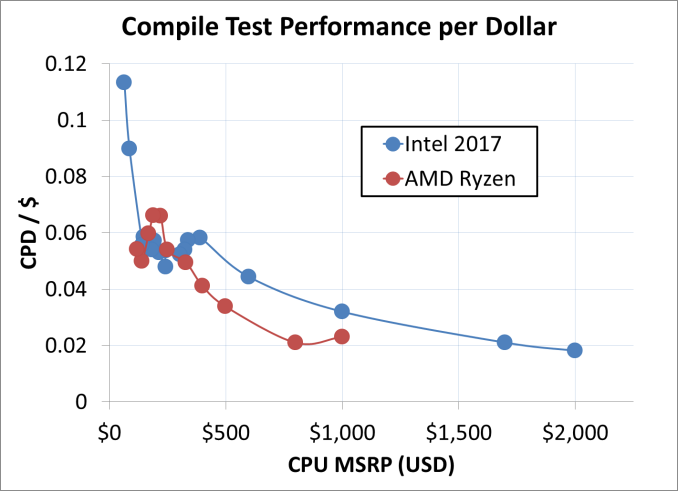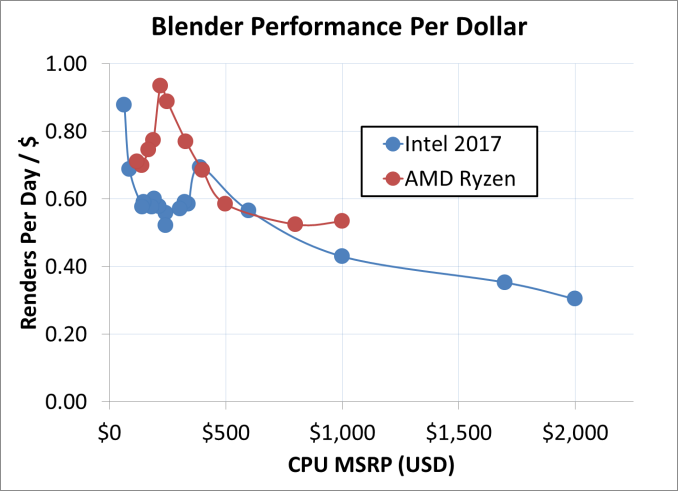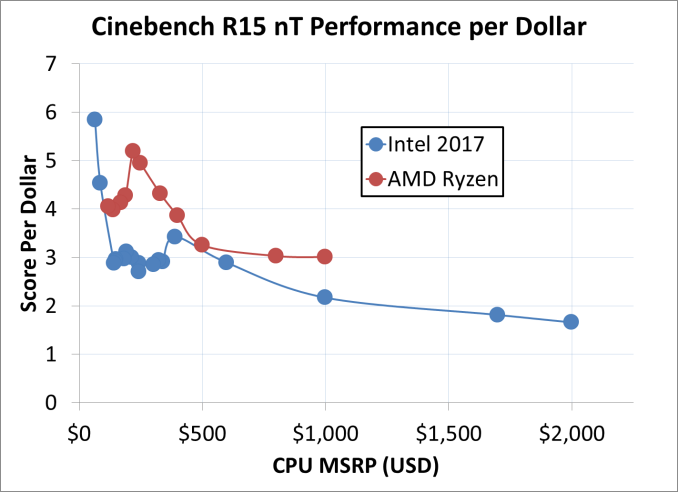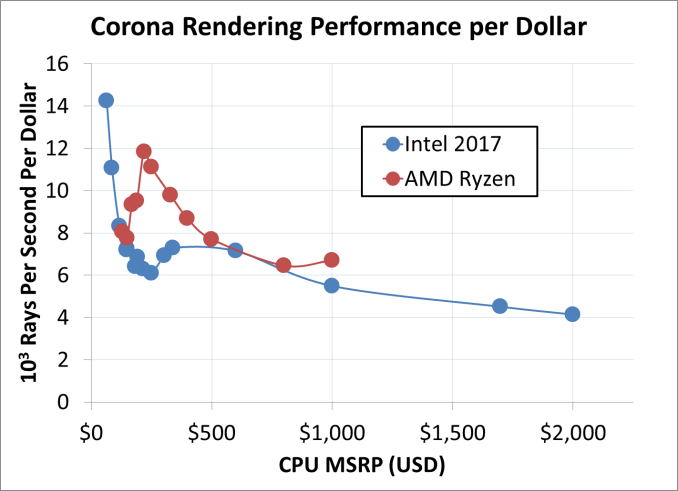The Intel Core i9-7980XE and Core i9-7960X CPU Review Part 1: Workstation
by Ian Cutress on September 25, 2017 3:01 AM ESTAnalyzing Performance Per Dollar
While measuring the performance per watt is an interesting metric, workstation processors are at the top of the stack when it comes to power consumption: the point of these processors (typically) is getting work done fast, and their users don't mind using a bit more power to get there. When it comes to designing a workstation level system for an office, the person who signs off on the project is not going to look at the performance per watt - they are going to look at the performance per dollar. Does this purchase represent the best value for the environment, and is the purchase likely to give us the best return? The following graphs attempt to answer that information, and we've chosen a varied selection including variable threaded loads.
For this analysis, we've taken all of the processors we have tested from what Intel has launched in 2017. This covers all of the consumer level Kaby Lake-S i7 and i5 parts (except T), the high-end desktop Kaby Lake-X processors, and all the high-end Skylake-X desktop parts. This is represented in the graphs in blue under the 'Intel 2017' title. From AMD, we have all eleven AMD Ryzen processors tested, under the red line.
Compile Performance Per Dollar
One of our popular benchmarks is our compile test. This takes a fixed version of Chromium v56, and runs it through the MSVC compiler with linking as per the directions given on by the Chromium developers. A typical test can run from 40 minutes to 3 hours depending on the processor, and taxes the single thread, the multi-thread and the memory performance of the system. We've seen that it does not particularly take kindly to processors with victim caches, such as Skylake-X or AMD Ryzen, with limited scaling on the code workflow. Despite the per-core performance dip from Skylake-S to Skylake-X, the top processor still has the best absolute performance. Converting our data to the number of compiles per day per dollar gives the following graph:
The cheaper end of the graph is surprisingly high, dominated by Intel's dual-core Pentium (with hyperthreading) being offered for super low prices. In the standard 'consumer' price range below $300, the mid-range Ryzen processors have a slight advantage, but, beyond the Ryzen 7 1700, Intel has the performance per dollar advantage all the way out to $2000.
Agisoft Performance Per Dollar
The Agisoft Photoscan software has been a key part of our performance testing for several years, demonstrating a true office workflow: archival purposes of taking 2D photos and converting them into 3D models. This is a computationally interesting algorithm, involving multiple single-threaded and multi-threaded stages.
Due to the single threaded elements of the algorithm, linear scaling is not observed as we ramp up through the core counts. At the mid-range consumer processor pricing, the twelve-thread Ryzen 5 processors sit above the quad-thread Core i5 parts, but beyond $330 or so, as we move into Intel's quad-core offerings and above, the performance per dollar is solely on Intel's side.
Blender Performance Per Dollar
The Blender benchmark has been an interesting debate in the last few months, with the new architectures from Intel and AMD pushing updates into the code for faster rendering. Our test takes a well used Blender release and one of the standard benchmarks (rather than anything vendor specified). Results are given in renders of this benchmark per day per dollar.
Interestingly AMD takes the peak PPD across the full range. At $999, where the competition is expected to be highest, AMD has over a 10% advantage. In the four digit range, even though the PPD of Intel's processors is lower, the absolute performance is still better. For our Blender test, this translates so a few seconds over a 2-3 minute test.
Cinebench R15 nT Performance Per Dollar
Next we move into the pure multithreaded benchmarks, which can be a significant number of workstation workloads. Here Intel might be at a disadvantage, with AMD offering more cores and more threads at each price point - Intel's IPC advantage will have to offset this in order to move ahead.
To lay some background here: AMD has been plugging Cinebench R15 nT benchmark numbers since the launch of Zen, citing better PPD. Intel's rebuttal is that in absolute performance, when you need the absolute best results, their hardware still wins.
Corona Rendering Performance Per Dollar
Ray tracing is another example of light threads taking advantage of more cores, more frequency, higher IPC and accelerated intructions with fast FP throughput. Citing back to Johan's EPYC review again, which showed AMD's good base FP performance, it will be an interesting comparison.
Similar to some of the previous graphs, the best PPD is held at Intel's low end Pentium processors - however these do not give the best overall throughput. In the mainstream price range, the Ryzen 5 1600 and 1600X are suprising peak results. In the $500-$800 range, Intel and AMD are about equal, however at $999 the Threadripper is ahead of the Core i9. Again, at the $1500+ range, Intel offers the better overall throughput, despite the lower PPD.















152 Comments
View All Comments
Spunjji - Monday, September 25, 2017 - link
Super relevant, because they indicate how badly thermally limited the CPU is - which is hella good info to have if you're, say, considering delidding a $1999 processor because the manufacturer used toothpaste under the IHS.tricomp - Monday, September 25, 2017 - link
Poor AMD...No chance they are going to supply (even more) cpu's demand after posting this article..
I am trying to purchase at list 7 systems for my customers in my country but there's nowhere I can find them beasts here..
iwod - Monday, September 25, 2017 - link
I wish someone could do an article on that too. GF doesn't seems to be the limitation here. GF, should in theory more then enough capacity in their Fab 8 for AMD. Unless GF have some other big customers, otherwise AMD should really be bumping out as much unit as possible.Atom11 - Monday, September 25, 2017 - link
Can we please see one test (!), if you could possible manage, that shows the advantage of AVX-512 in compare to AVX2 when doing:1.) matrix multiply
2.) FFT
3.) convolution
ZeDestructor - Monday, September 25, 2017 - link
Give us a comparison to AVX1 and SSE4 too!Gothmoth - Monday, September 25, 2017 - link
threadripper delivers 80+% of the perfromance for less than 50% of the price.... you don´t have to be a genius to see what the better deal is (price germany: TR 1950x = 950 euro, 7890xe =2300 euro)Spunjji - Monday, September 25, 2017 - link
Don't let that stop them equivocating about how companies who need that power yet somehow have no need for ECC don't care about cost because something something software TCO blah blah.spdragoo - Monday, September 25, 2017 - link
I'm trying really, really hard to think of a company that, at some point or another, doesn't say, "Equipment X may outperform Equipment Y, but the extra cost to buy Equipment X is too much, we'll just make-do with Y instead." Especially since 100% of companies have a limit on their budgets.What's that, you say? Multi-billion dollar corporations don't have to worry about the money they spend? Someone apparently didn't pay attention in their Econ 200 class, or their Introduction to Accounting coursework.
By definition, every business has a *finite* amount of money they can spend, based on a) how much money they collect from their customers, b) how much they can recoup on the sale of assets (tangible or intangible), & c) how much they can get from "other sources" (mostly bank loans or by selling stock shares, or sometimes government grants, but you might find the occasional situation where a generous benefactor just bequeaths money to a company...but I doubt you'll even see that happen to 1% of the companies out there -- & no, venture capitalists pouring money into a company is *not* a situation where they "give the money away", they're getting something for their money, usually stock shares or guarantees of repayment of the loans). Of that money, some of it is earmarked for employee compensation (not just the executives, but the office drones & lower-level employees that do 99% of the actual work), some of it goes towards taxes, some of it pays for rental payments, some for loan payments, some for utilities (telephone, Internet, electricity, gas, water, etc.), some of it may get set aside for "emergencies", some gets earmarked for dividends to the shareholders, etc. That means that a (relatively) small portion is set aside for "equipment replacement". Now, if the company is lucky, the lion's share of that budget is for IT-related equipment...but that covers more than just the office drones' machines, that covers everything: server racks, storage services, cloud vendor payments, etc.
And that is where the price comes into play. For probably 90% of office users out there, not only is Threadripper an overpowered product, so are these products. Heck, we're in the middle of an upgrade from Windows 7 to Windows 10, & they're taking the opportunity to replace our old Sandy Bridge i5 machines with Skylake i7 machines. Sure, they're running faster now...but the main reason they're running faster is because we went from 32-bit Windows to 64-bit Windows, so our PCs now have 8GB of RAM instead of 4GB. That helps with our workload...which primarily revolves around MS Office & using browsers to access & modify a number of massive databases. Having an 8C/16T CPU, let alone a 16C/32T CPU, wouldn't provide any boost for us, since the primary slowdown is on the server side.
These are going to be expensive systems for specialized purposes...& those individual companies are going to look at their budgets very closely, as well as the performance benchmarks, before deciding to purchase these systems. Sure, they may hold the performance crown...but not by that big of a margin, & especially when compared to the margin that gives them the "most expensive price" crown.
BrokenCrayons - Monday, September 25, 2017 - link
Human labor is more expensive than hardware. The 20% additional performance for $1000 more can be earned back quickly by the increased productivity of your workforce (assuming your management staff is effective enough to keep the employees gainfully employed of course and that's certainly not always the case).vladx - Tuesday, September 26, 2017 - link
Indeed the difference in price is pretty much negligible in a professional setting.